Content for TS 23.433 Word version: 19.4.0
0…
4…
7…
8…
9.2…
9.2.2.3…
9.2.3…
9.2.4…
9.3…
9.3.2.2…
9.3.3…
9.3.4…
9.4…
9.5…
9.5.3…
9.5.4…
9.6…
9.7…
9.7.3…
9.7.4…
9.8…
9.9…
9.9.3…
9.10…
9.10.3…
9.11…
9.11.3…
9.12…
9.12.3…
9.13
10…
A…
C
D…
7 Architecture
7.1 General
7.2 Architecture
7.3 Functional entities
7.3.1 General
7.3.2 SEAL Data Delivery server
7.3.3 SEAL Data Delivery client
7.4 Reference points
7.4.1 General
7.4.2 SEALDD-UU
7.4.3 SEALDD-C
7.4.4 SEALDD-S
7.4.5 SEALDD-E
7.4.6 N6
7.4.7 N33/N5
7.4.8 SEALDD-UUc
7.4.9 SEALDD-PC5
7.4.10 SEALDD-X
7.5 Cardinality rules
7.5.1 General
7.5.2 Functional Entity Cardinality
7.5.2.1 VAL client
7.5.2.2 SEALDD client
7.5.2.3 SEALDD server
7.5.2.4 VAL server
7.5.3 Reference Point Cardinality
7.5.3.1 SEALDD-C (Between VAL client and SEALDD client)
7.5.3.2 SEALDD-S (Between VAL layer and SEALDD server)
7.5.3.3 SEALDD-UU (Between SEALDD client and SEALDD server)
7.5.3.4 SEALDD-E (Between SEALDD server and SEALDD server)
7.5.3.5 SEALDD-PC5 (Between SEAL clients of two VAL UEs)
7.5.3.6 SEALDD-X (Between SEALDD server and other SEAL server)
7.5.3.7 SEALDD-UUc (Between the SEALDD client on the tethered device and SEALDD client on the 3GPP UE)
...
...
7 Architecture p. 18
7.1 General p. 18
The architecture for the SEAL data delivery enabler is based on the generic functional model specified in clause 6.2 of TS 23.434.
This clause provides the overall architecture description:
- Clause 7.2 describes the functional architecture;
- Clause 7.3 describes the functional entities;
- Clause 7.4 describes the reference points; and
- Clause 7.5 describes the cardinality of functional entities and reference points.
7.2 Architecture p. 19
This clause describes the architecture for enabling SEAL Data Delivery applications in the following representations:
- A service-based representation as specified in TS 23.434, where the SEAL Data Delivery Enabler Layer functions (e.g. SEALDD server) enable other authorized Vertical Application Layer functions (e.g. VAL server) to access their services.
- A service-based representation as specified in TS 23.501, where the Network Functions (e.g. NEF) enable authorized SEAL Data Delivery Layer functions (e.g. SEALDD server) i.e. Application Functions, to access their services;
- A service-based representation, where the Core Network Northbound APIs as specified in TS 23.501 and TS 23.502, are utilized by authorized SEAL Data Delivery Enabler Layer functions via CAPIF core function specified in TS 23.222; and
- A reference point representation, where existing interactions between any two functions (e.g. SEALDD client and SEALDD server) is shown by an appropriate point-to-point reference point (e.g. SEALDD-UU).
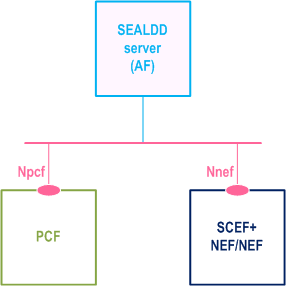
The SEALDD server acts as AF for consuming network services from the 3GPP 5G Core Network entities over the Service Based Architecture specified in TS 23.501.
Figure 7.2-2 illustrates the service-based representation for utilization of the Core Network (5GC, EPC) northbound APIs via CAPIF.
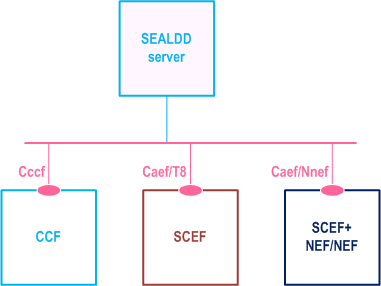
The SEALDD server acts as authorized API invoker to consume services from the Core Network (5GC, EPC) northbound API entities like SCEF, NEF, SCEF+NEF which act as API Exposing Function as specified in TS 23.222.
The mechanism for northbound APIs discovery using the service-based interfaces depicted in Figure 7.2-3 is as specified in TS 23.222.
Figure 7.2-3 illustrates the architecture for SEAL Data Delivery enabler service.
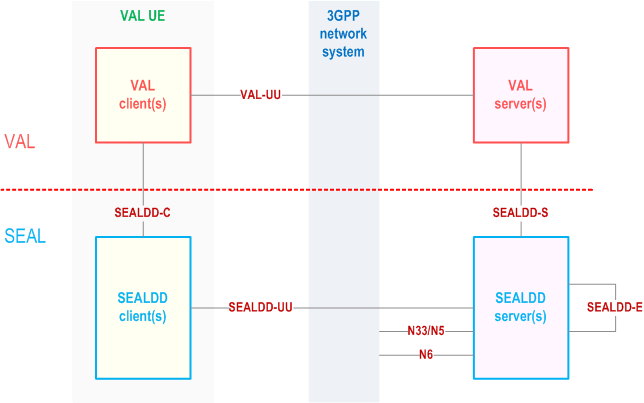
The SEALDD server can communicate with the control plane of 3GPP core network via N33/N5 interface with the SEALDD control plane functionality. The SEALDD server may consume other SEAL (e.g. NRM) services.
For uplink traffic, VAL client sends application data traffic to SEALDD client for SEALDD service over SEALDD-C. After data plane packet processing by SEALDD client, the application data traffic is converted to SEALDD data traffic and transferred to SEALDD server over SEALDD-UU. The SEALDD server restores the application data traffic and sends it to VAL server over SEALDD-S. For downlink traffic, VAL server sends application data traffic to SEALDD server for SEALDD service over SEALDD-S. After data plane packet processing by SEALDD server, the application data traffic is converted to SEALDD data traffic and transferred to SEALDD client over SEALDD-UU. The SEALDD client restores the application data traffic and sends it to VAL client over SEALDD-C. Optionally, VAL deployments may choose to route application signalling traffic and application data traffic for some or all functions it offers using SEALDD service and Figure 7.2-4 illustrates the architecture for achieving this. In this case the VAL client and VAL server may choose not to maintain application connection by themselves and transfer all the application traffic over SEALDD connections for those functions. The data storage functionality may be provided by SEALDD server or provided by other storage functions in VAL server, or other cloud platform.
To facilitate the specific optimization for XR application provided by 5G network, the application enablement architecture for the XRApp service is based on the generic functional model specified in TS 23.434.
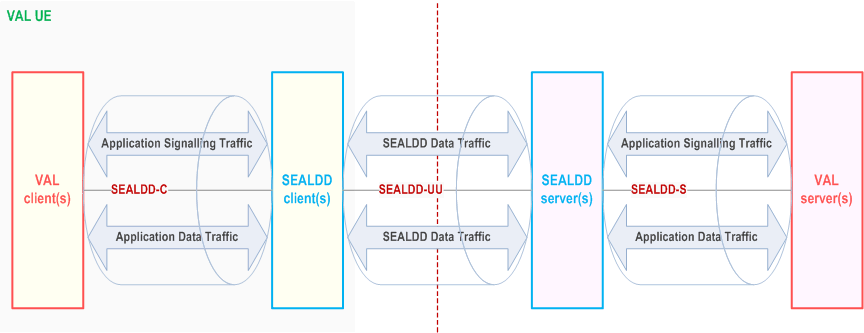
The SEAL Data Delivery client interacts with the SEAL data delivery server to establish application layer data transport path.
Through this path, the SEALDD server and client provides data transport service capabilities such as data plane packet processing (e.g. packet duplication, elimination or transport coordination), data forwarding, data caching, background data transfer, etc. to support the VAL server and VAL client. Annex C describes a typical lifecycle of SEALDD to establish the SEALDD connection for the VAL client and VAL server.
Figure 7.2-5 illustrates the architecture for SEAL Data Delivery enabler service used to support UE-to-UE communication.
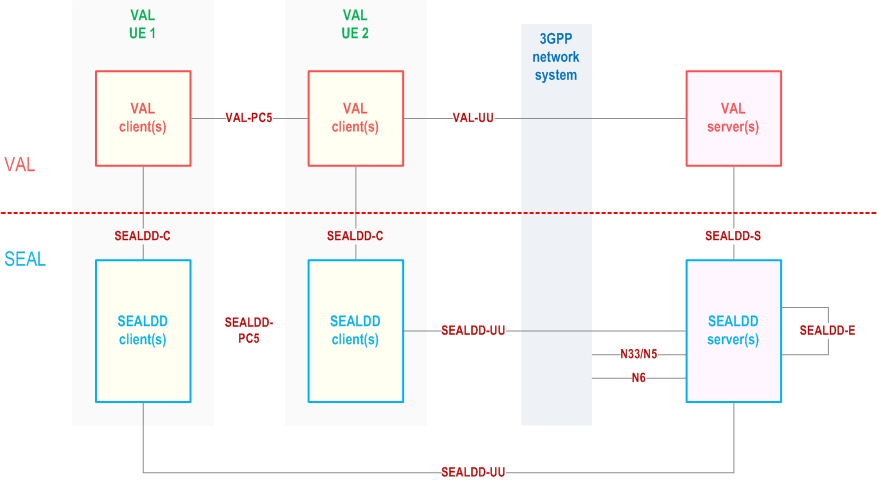
VAL UE 1 and VAL UE 2 have on-network connectivity, and both VAL UEs can directly communication with each other via off-network connectivity (i.e. SEALDD-PC5 reference point) or via on-nework connectivity (i.e. SEALDD-UU reference point).
Multi-modal services are based on several data flows related to each other and subject to application coordination. The data flows can transfer different types of data (for example audio, video, positioning, haptic data) and may come from different sources(e.g. a single UE, a single device or multiple devices connected to the single UE, or multiple UEs).
Figure 7.2-6 illustrates XR multi-modal services using two different XR Servers. To support E2E multi-modal communication flows between multiple VAL clients and servers, a SEALDD server and clients may support multi-modal service capabilities. The SEALDD server and clients perform multi-modal traffic transfer and management processing (e.g., E2E synchronization of application traffic having multi-modal dependencies with one another).
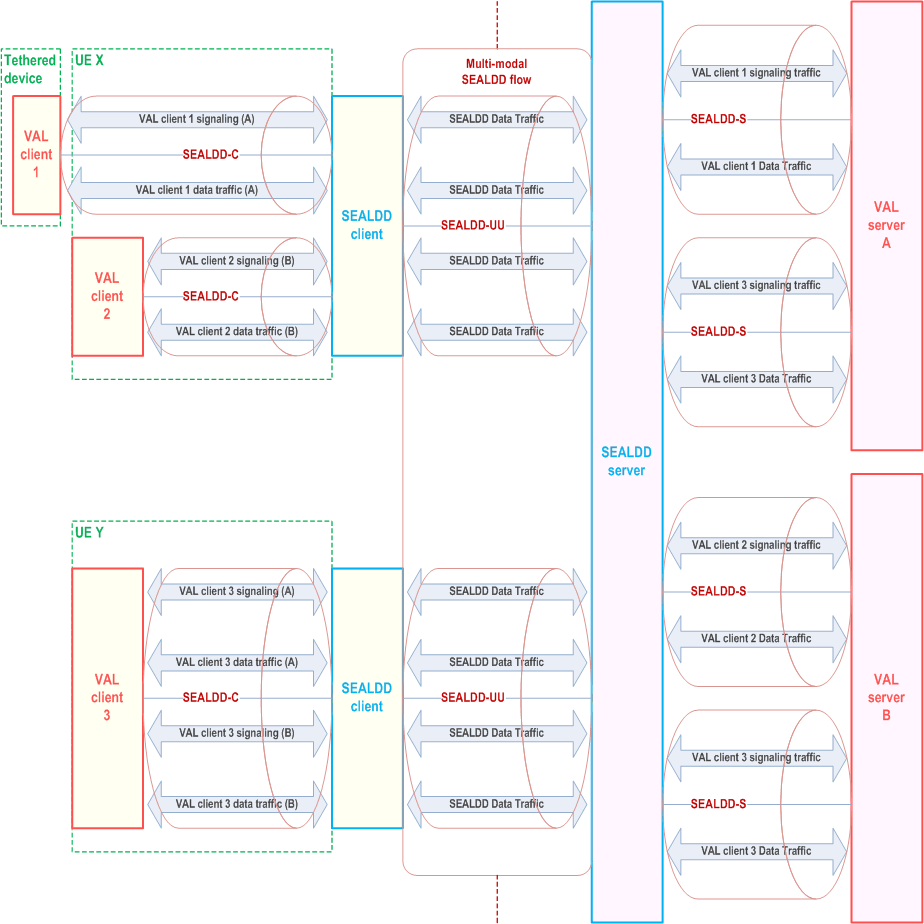
To support the Tethered device, there are two types of Application enablement architectures based on SEALDD and PINAPP, corresponding to two types of tethered devices. One is the tethered XR device, where XR application client is deployed on the tethered XR device, i.e., Tethered Standalone AR Glasses, and Tethered AR Glasses with 5G Relay. The other is the Tethered Display XR device, who deploys the XR application on the 5G client, with only the XR runtime residing on the tethered UE.
For the tethered XR device, the application enablement layer architecture is shown in the Figure 7.2-7. The SEALDD client on the 3GPP UE, acting as PIN client, could get tethered device information from the PEMC using the PIN-3 interface. Then the SEALDD client could interact with XR client on the tethered device to do the tethered link measurement. The interaction between the SEALDD client and XR client on different device is conducted over SEALDD-C.
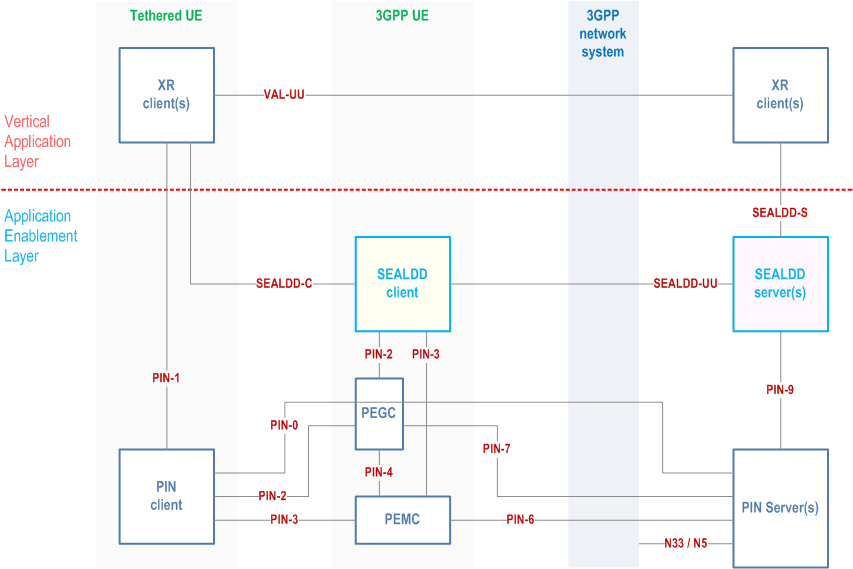
For the Tethered Display XR device, the application enablement layer architecture is shown in the Figure 7.2-8. The SEALDD client on the 3GPP UE, acting as PIN client, could get tethered device information from the PEMC using the PIN-3 interface. The SEALDD-UUc interface supports the interaction between the SEALDD client on the tethered UE and SEALDD client on the 3GPP UE.
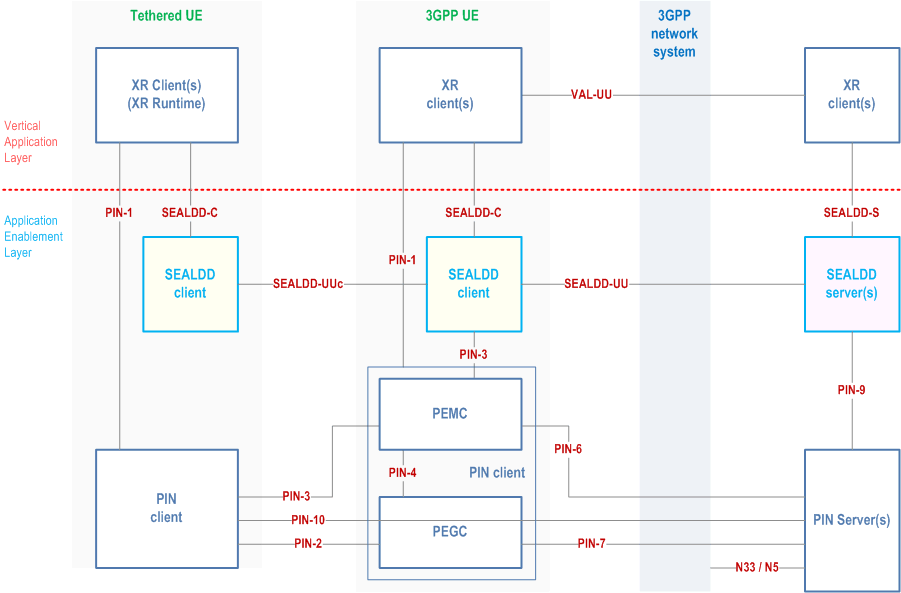
7.3 Functional entities p. 24
7.3.1 General p. 24
The functional entities for SEALDD service are described in the following clauses.
7.3.2 SEAL Data Delivery server p. 24
The SEAL data delivery server functional entity acts as the application server for the data delivery enablement. The SEALDD server supports the following capabilities:
- Support the signalling interaction with VAL server to negotiate the data delivery aspects including QoS requirement, protocols information, bandwidth settings, delivery policy provisioning, transmission quality measurement, background data transfer.
- Support the signalling interaction with the SEALDD client to management the data delivery between the SEALDD server and the SEALDD client, including the establish/update/release of signalling plane and user plane of SEALDD-UU, bandwidth control, transmission quality measurement.
- Providing the application data/media storage.
- Interacting with 5GC via N33/N5 (i.e. send control plane requirements or receive control plane notification) with usage of capability exposed by 3GPP network.
- Support user plane handlings including obtaining the application data/media and/or application signalling data from VAL server via SEALDD-S, delivering it to the SEALDD client via the SEALDD-UU, and receiving the application data/media and/or application signalling data from SEALDD client and providing it to the VAL server via SEALDD-S, enforce the rate control.
7.3.3 SEAL Data Delivery client p. 24
The SEAL data delivery client functional entity acts as the application client for the data delivery enablement. The SEALDD client supports the following capabilities:
- Interact with the SEALDD server to management the data delivery between the SEALDD server and the SEALDD client, including the establish/update/release of signalling and user plane of SEALDD-UU, bandwidth control, transmission quality measurement.
- Support user plane handlings including obtaining the application data/media and/or application signalling data from VAL client, delivering it to the SEALDD server via the SEALDD -UU, and receiving the application data/media and/or application signalling data from SEALDD client, providing it to the VAL server via the SEALDD-S.
7.4 Reference points p. 24
7.4.1 General p. 24
The reference points for the functional model for SEALDD are described in the following clauses.
7.4.2 SEALDD-UU p. 24
SEALDD-UU reference point is between the SEALDD client and the SEALDD server. It supports the user plane functionality of transferring data content and the signalling plane functionality of exchanging information for SEALDD service provisioning, control, reporting etc.
7.4.3 SEALDD-C p. 25
Reference point between SEALDD client and VAL client to enable northbound client side API exposed by SEALDD client to VAL client for data delivery and SEALDD service provisioning, control, reporting etc. This reference point should also enables the interaction between the VAL client on the tethered device and SEALDD client on the 3GPP device to support the tethering link management(e.e., measurement etc.).
7.4.4 SEALDD-S p. 25
SEALDD-S reference point is between the SEALDD server and the VAL server. It supports the user plane functionality of data content delivery and the signalling plane functionality SEALDD service provisioning, control, reporting etc.
7.4.5 SEALDD-E p. 25
Reference point enables interactions between two SEALDD servers to transfer data content and exchange information for SEALDD service provisioning, control, reporting etc.
7.4.6 N6 p. 25
Reference point enables interactions between SEALDD server and 5GC to transfer SEALDD traffic packets.
7.4.7 N33/N5 p. 25
Reference point enables interactions between SEALDD server and 5GC to send control plane requirements or receive control plane notification for optimized data transmission.
7.4.8 SEALDD-UUc |R19| p. 25
Reference point enables the interactions between the SEALDD client on the tethered device and SEALDD client on the 3GPP device.
7.4.9 SEALDD-PC5 |R19| p. 25
SEALDD-PC5 reference point is between the SEAL clients of two VAL UEs. This reference point utilizes PC5 reference point as described in TS 23.303 or TS 23.304. It supports the user plane functionality of transferring data content and the signalling plane functionality of exchanging information for SEALDD service provisioning, control, reporting etc.
7.4.10 SEALDD-X |R19| p. 25
Reference point enables interactions between the SEALDD server and other SEAL enablers to exchange information for SEALDD service provisioning, control, reporting etc.
7.5 Cardinality rules p. 25
7.5.1 General p. 25
The cardinality rules for the SEALDD entities and SEALDD reference points are described in the following clauses.
7.5.2 Functional Entity Cardinality p. 26
7.5.2.1 VAL client p. 26
The following cardinality rules apply for VAL clients:
- One or more VAL client(s) may be located in a VAL UE.
7.5.2.2 SEALDD client p. 26
The following cardinality rules apply for SEALDD clients:
- One or more SEALDD client(s) may be located in a VAL UE.
7.5.2.3 SEALDD server p. 26
The following cardinality rules apply for SEALDD server:
- One or more SEALDD server(s) may be located in network.
7.5.2.4 VAL server p. 26
The following cardinality rules apply for VAL server:
- One or more VAL server(s) may be located in network.
7.5.3 Reference Point Cardinality p. 26
7.5.3.1 SEALDD-C (Between VAL client and SEALDD client) p. 26
The following cardinality rules apply for the reference of SEALDD-C:
- One VAL client may communicate with only one SEALDD client; and
- One SEALDD client may communicate with one or more VAL client(s) concurrently.
7.5.3.2 SEALDD-S (Between VAL layer and SEALDD server) p. 26
The following cardinality rules apply for the reference of SEALDD-S:
- One VAL server may communicate with one or more SEALDD server; and
- One SEALDD server may communicate with one or more VAL server(s) concurrently.
7.5.3.3 SEALDD-UU (Between SEALDD client and SEALDD server) p. 26
The following cardinality rules apply for the reference of SEALDD-UU:
- One SEALDD client may communicate with one or more SEALDD servers.
- One SEALDD server may communicate with one or more SEALDD client(s) concurrently.
7.5.3.4 SEALDD-E (Between SEALDD server and SEALDD server) p. 26
The following cardinality rules apply for the reference of SEALDD-E:
- One SEALDD server may communicate with one or more SEALDD server(s) concurrently.
7.5.3.5 SEALDD-PC5 (Between SEAL clients of two VAL UEs) |R19| p. 27
The following cardinality rules apply for the reference of SEALDD-PC5:
- One SEALDD client may communicate with one or more SEALDD client(s) concurrently.
7.5.3.6 SEALDD-X (Between SEALDD server and other SEAL server) |R19| p. 27
The following cardinality rules apply for the reference of SEALDD-X:
- One SEALDD server may communicate with one or more SEAL server(s) concurrently.
7.5.3.7 SEALDD-UUc (Between the SEALDD client on the tethered device and SEALDD client on the 3GPP UE) |R19| p. 27
The following cardinality rules apply for the reference of SEALDD-UUc:
- One SEALDD client may communicate with one or more SEALDD client (s) concurrently.